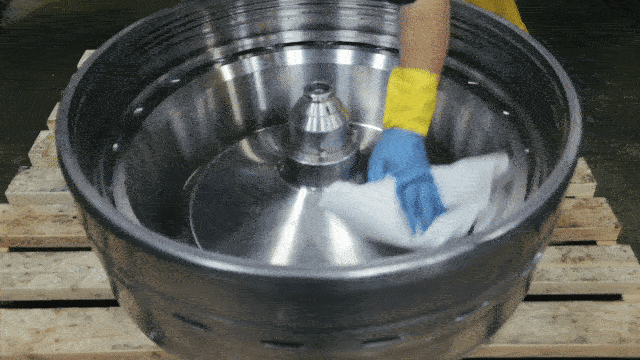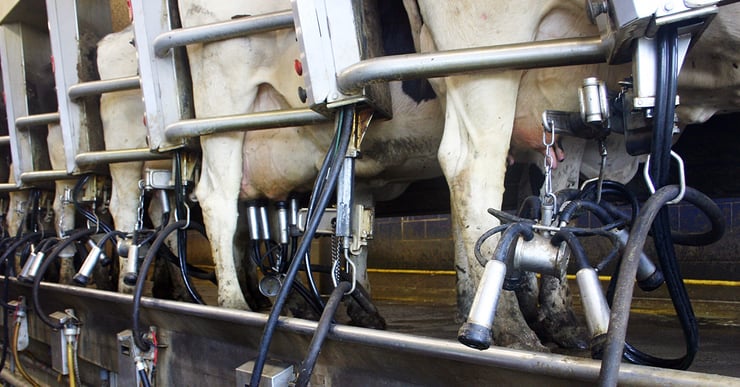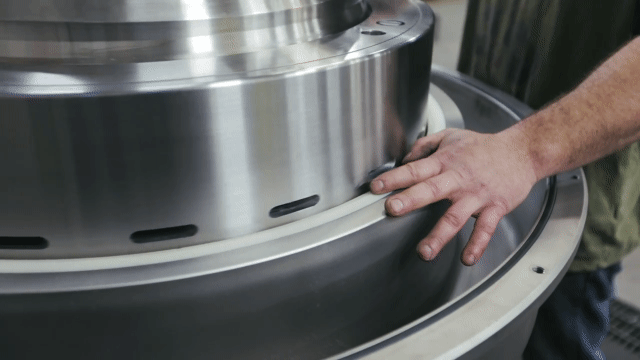From eating syrup on your pancakes to wearing a silver necklace, you have benefitted from industrial centrifuges far more often than you probably realize. Yet, despite a centrifuge’s integral role in our society, many people have never heard of this vital piece of equipment.
Centrifuges are used across a wide range of industries including food processing, wastewater treatment, mining, pharmaceutical, and biofuel.
So, let’s explore what centrifuge machines do, and why we depend on them to create so many of the products we use today.
What happens when you turn on a centrifuge machine?
A centrifuge works by rotating at rapid speeds, thereby separating substances using the power of centripetal force (and the apparent centrifugal “force” — more on that concept later). The force applied can reach several hundred or several thousand times that of the earth’s gravity.
If you want to literally feel the force behind centrifugation for yourself, grab a solid object about the size of an apple. Hold your object at arm’s length, and spin in a circle. As you spin faster, you’ll be able to feel a physical pull of that object on your arm. Spin faster, and that force gets even stronger. If you were to release that object, it would fly in a straight line that’s tangential to the circle you created.
That’s exactly what’s happening inside a centrifuge bowl. So let’s explore the physics behind centripetal force.
The physics of centrifugation
If you performed the experiment above, you would feel two equal and opposite forces at play.
The first was the force generated by your rotation, which translates to velocity for the object you held in your hand.
The second was the tug you felt on your arm as it worked to constantly redirect your object’s vector and prevent it from flying across the room. This is known as centripetal force.
Centripetal force can be defined as the force that acts on an object in order to direct it toward a center of curvature. It’s the very essence of what makes a centrifuge work.
What is centrifugal force?
Centrifugal force isn’t technically a “force” at all. It’s actually defined as an “apparent” force, since the object only feels it as the result of inertia.
We all know that an object in motion stays in motion unless acted upon by an outside force. So without a strong enough centripetal force to alter its vector, an object naturally wants to move in a straight line.
A wall (or basket, in some cases) in a centrifuge prevents that object from doing this. So really, what the object feels is its own force acting upon the wall.
It’s similar to the principle that causes you to feel a tug from your seatbelt when you slam your car’s brakes suddenly. Your seatbelt isn’t actually pushing on you; it’s preventing you from continuing to move forward like the coffee in your cup holder did.
What is the role of a centrifuge in production?
The purpose of a centrifuge is to take advantage of the principles above and use them to separate liquids from solids (or lighter liquids from denser liquids). In essence, it does what gravity would naturally do, but much faster.
Think about a bottle of fresh-squeezed orange juice. The pulp naturally settles on the bottom because it’s denser than the juice itself.
If you were impatient and didn’t feel like waiting for gravity to work its magic, you could use a centrifuge — which enacts a force much stronger than gravity — in order to speed up the process.
Common types of industrial centrifuges
We largely work with two types of industrial centrifuges: high-speed vertical centrifuges and low-speed horizontal decanter centrifuges.
High-speed vertical centrifuges
High-speed centrifuges allow for continuous, large-scale fluid separation in industrial settings. Running at high RPM (up to 26,000 RPM), these centrifuges can clarify milk by achieving full separation of a product. They are not meant to handle high solid loads (though they can handle solid loads of up to 0.5% for solid bowl centrifuges and up to 10% for discharging centrifuges).

An example of a high-speed vertical centrifuge is a discharging disc stack centrifuge, which includes a bowl with perforated holes that allow liquid to pass through the basket as it rotates. This prevents denser solids from passing through the holes. For example, washing machines are considered discharging disc stack centrifuges, allowing water to exit the bowl while keeping the product (your laundry) inside.
Discharging disc stack centrifuges are often used for rendering, separating crystalized sugars from maple syrup, and chemically processing salt.
Low-speed horizontal decanter centrifuges
While high-speed centrifuges do not have the internal space to accommodate a large amount of solids, low-speed horizontal centrifuges, often referred to as decanters, are used for applications that have high solid loads (35%–40% solids). These low-speed centrifuges can maintain dry-solids discharge and often run up to 4,000 RPM; however, they are not built to be used in the clarifying process.
Learn more about the separation process
Centripetal force is a powerful separating tool, and having a high-performing centrifuge can make or break certain businesses.
Interested in taking a closer look at industrial centrifuges? Learn more about what makes up these machines, what industries use them, and how plants maintain them.

